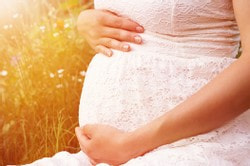During pregnancy the needs for iron increase by up to 100 %.


Iron is a basic element for the blood pigments haemoglobin and myoglobin. Haemoglobin facilitates the oxygen transport in the body whereas myoglobin is the storage form for oxygen and is found as a reservoir in the muscles. Therefore iron plays a significant role in the organism which can only work with a sufficient oxygen supply.
According to the reference value of the German Association for Nutrition, healthy male adults should take 10 mg of the trace element every day. The reference value for women is 15 mg. However this value increases to 30 mg iron daily for pregnant women and 20 mg for breastfeeding women. (Source: German Association for Nutrition)
Due to loss of blood, higher need of iron or lower intake, there is frequently a risk of iron deficiency in:
Possible symptoms of a low iron level are fatigue, tiredness, forgetfulness, sleeping disorders and a general reduction in productivity. There are also external signs for a lack of iron, e.g. pale skin, chapped lips and brittle fingernails.
Generally, the body's ability to absorb iron can be increased by the simultaneous intake of vitamin C whereas fibres as well as calcium or tannins in coffee and tea inhibit iron absorption. Meat, especially red lean meat, and innards like liver, but also legumes, whole-grain products and vegetables contain iron. It is important to consider that iron is contained in different forms in animal products and vegetarian food and the organism can absorb the bivalent iron in animal products better than the trivalent iron in vegetarian food.
It is recommended to consult a doctor in the case of a higher risk or suspected low iron level. If there is a higher need for iron the doctor can recommend a supplementation with an iron preparation, according to the degree of the deficiency, if the diet cannot meet this need. The possibilities of substitution range from liquid preparations to capsules and tablets.